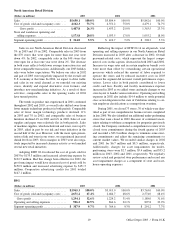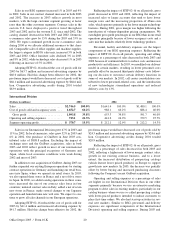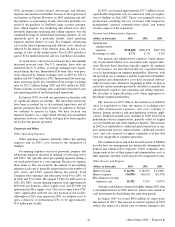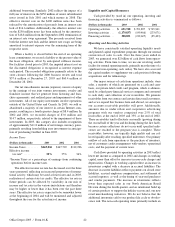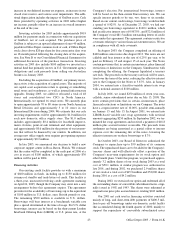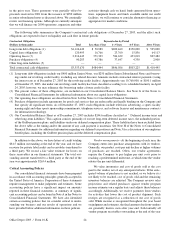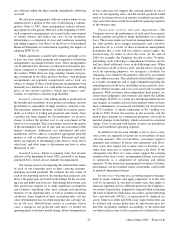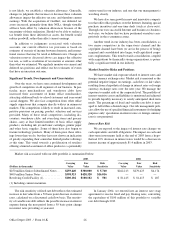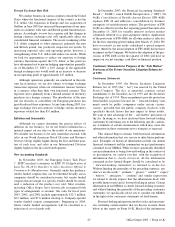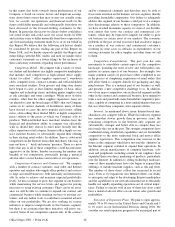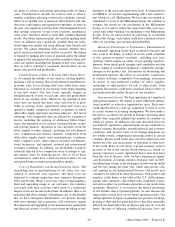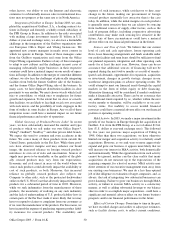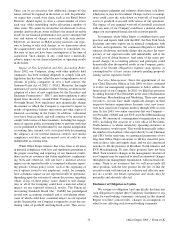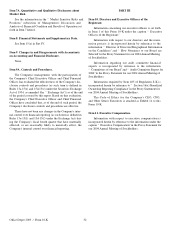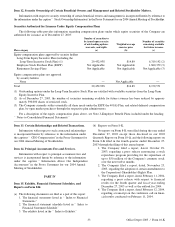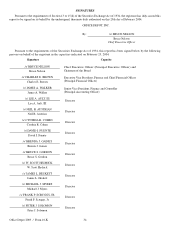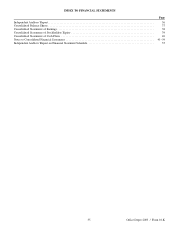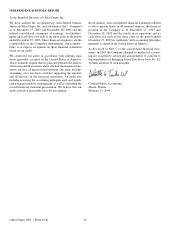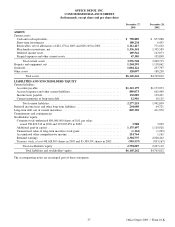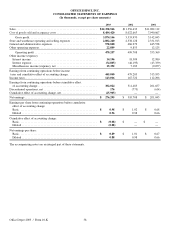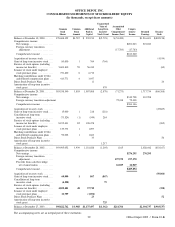Office Depot 2003 Annual Report Download - page 31
Download and view the complete annual report
Please find page 31 of the 2003 Office Depot annual report below. You can navigate through the pages in the report by either clicking on the pages listed below, or by using the keyword search tool below to find specific information within the annual report.our plans to achieve anticipated operating results in future
years. Circumstances outside our control, such as adverse
weather conditions affecting construction schedules, unavail-
ability of acceptable sites or materials, labor disputes and sim-
ilar issues could impact anticipated store openings. At times in
the past, our expansion activities have been hampered by less
than optimal selection of real estate locations, resulting in
some stores that have failed to meet their planned financial
results. Our future expansion plans also include opening retail
stores of different sizes (generally smaller) than our tradi-
tional superstore models and using different store formats and
layouts. We cannot determine with certainty whether these
newly sized or formatted stores will be successful. The failure
to expand by opening new stores as planned and/or the failure
to generate the anticipated sales growth in markets where new
stores are opened (including the opening of new sizes and for-
mats of stores) could have a material adverse effect on our
future sales growth and profitability.
Cannibalization of Sales in Existing Office Depot Stores:
As we expand the number of our stores in existing markets,
pursuing a ‘fill-in’strategy that is both offensive and defensive
in nature, sales in our existing stores may suffer from canni-
balization (as customers of our existing stores begin shopping
at our new stores). Our new stores typically require an
extended period of time to reach the sales and profitability
levels of our existing stores. Moreover, the opening of new
stores does not ensure that those stores will ever be as prof-
itable as existing stores, particularly when new stores are
opened in highly competitive markets or markets in which
other office supply superstores may have achieved “ first mover”
advantage. Our comparable sales are affected by a number of
factors, including the opening of additional Office Depot
stores; the expansion of our contract stationer business in new
and existing markets; migration of our customers from the
retail channel to other channels, including our own Internet
sites, commercial and contract channels, competition from
other office supply chains, mass merchandisers, warehouse
clubs, computer stores, other contract stationers and Internet-
based businesses; and regional, national and international
economic conditions. In addition, our profitability would be
adversely affected if our competitors were to attempt to cap-
ture market share by reducing prices. Any or all of these
circumstances could have a material adverse effect on our
anticipated future revenue and profitability models.
Costs of Remodeling and Re-merchandising Stores: The
remodeling and re-merchandising of our stores has con-
tributed to increased store expenses, and these costs are
expected to continue impacting store expenses throughout
2004 and beyond. While a necessary aspect of maintaining a
fresh and appealing image to our customers, the expenses
associated with such activities could result in a significant
impact on our net income in the future. In addition, there is no
guarantee that these changes will generate any of the benefits
that we have anticipated. Furthermore, our growth, through
both store openings and acquisitions, will continue to require
the expansion and upgrading of our informational, operational
and financial systems, as well as necessitate the hiring of new
managers at the store and supervisory level. As mentioned in
our MD&A, we are also experimenting with a new retail for-
mat which we call ‘Millennium.’We have thus far opened or
remodeled 11 stores to the Millennium design. We continue to
evaluate the return on our investment in the Millennium
design, as we seek to reduce the capital and other costs asso-
ciated with either building or remodeling to the Millennium
design. If we are unsuccessful in achieving an acceptable
ROI on this design, such failure could have a material adverse
effect on our future sales growth and profitability.
Historical Fluctuations in Performance: Fluctuations in
our quarterly operating results have occurred in the past and
may occur in the future. A variety of factors could contribute
to this quarter-to-quarter variability, including new store
openings which require an outlay of pre-opening expenses,
generate lower initial profit margins and cannibalize existing
stores; timing of warehouse integration; competitors’pricing;
changes in our product mix; fluctuations in advertising and
promotional expenses; the effects of seasonality; acquisitions
of contract stationers; competitive store openings; an increase
in activity by non-traditional resellers of office supplies,
technology or other products we sell, or other events. Such
quarterly fluctuations could have a material adverse effect on
our financial results and/or the price of our securities.
International Activity: We have operations in a number of
international markets. We intend to enter additional interna-
tional markets as attractive opportunities arise. Each entry
could take the form of a start-up, acquisition of stock or assets
or a joint venture or licensing arrangement. We have made a
decision to accelerate our growth in Europe, increasing more
rapidly than originally planned the number of countries in
which we operate. In addition to the risks described above (in
our domestic operations), internationally we face such risks as
foreign currency fluctuations, unstable political and economic
conditions, and, because some of our foreign operations are
not wholly owned, compromised operating control in certain
countries. Recent world events have served to underscore even
further the risks and uncertainties of operating in other parts
of the world. Risks of civil unrest, war and economic crisis in
portions of the world outside North America in which we
operate represent a more significant factor than may have
been the case in the past. Also, we have experienced signifi-
cant fluctuations in foreign currency exchange rates in 2003,
including large swings in the exchange rate between the dollar
and the euro during the prior year, which affected the sales
and earnings in our International Division. Our results may
continue to be affected by these fluctuations, both positive and
negative, in the future as the value of the U.S. dollar changes
against other currencies. All of these risks could have a mate-
rial adverse effect on our financial position or our results from
operations. Moreover, as we increase the relative percentage
of our business that is operated globally, we also increase the
impact these factors have on our future operating results. Our
startup operation in Japan, in particular, has proven to be disap-
pointing to date and has generated losses that have materially
affected our financial results in the past and may do so in the
future. Because of differing commercial practices, laws and
29 Office Depot 2003 / Form 10-K


